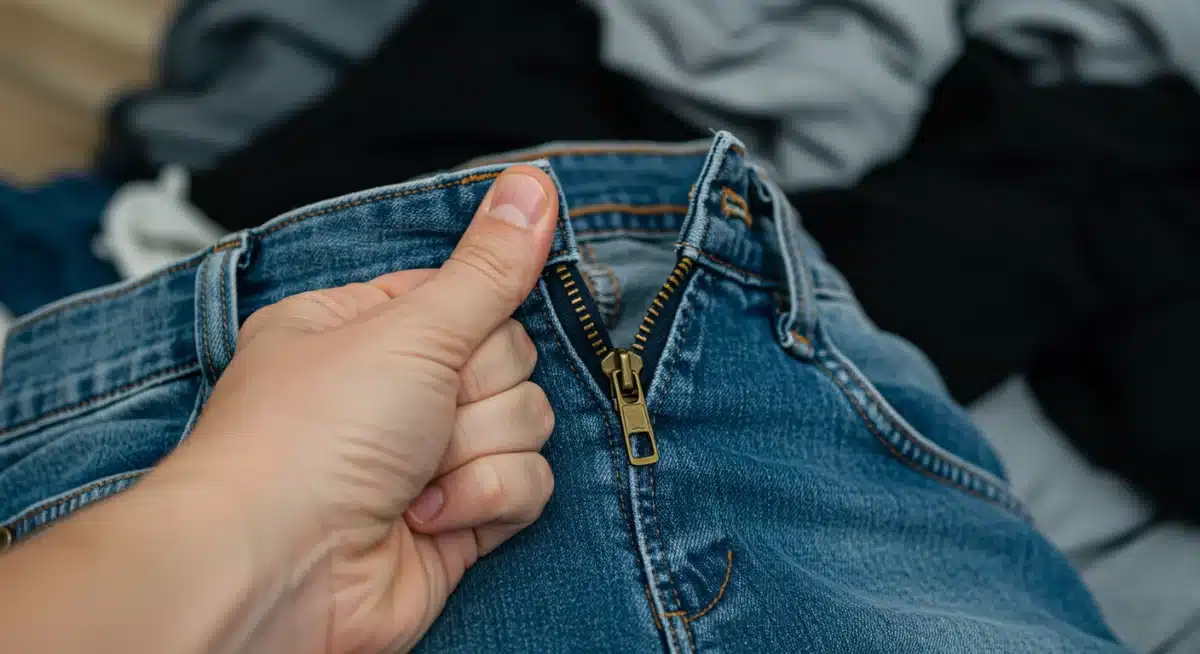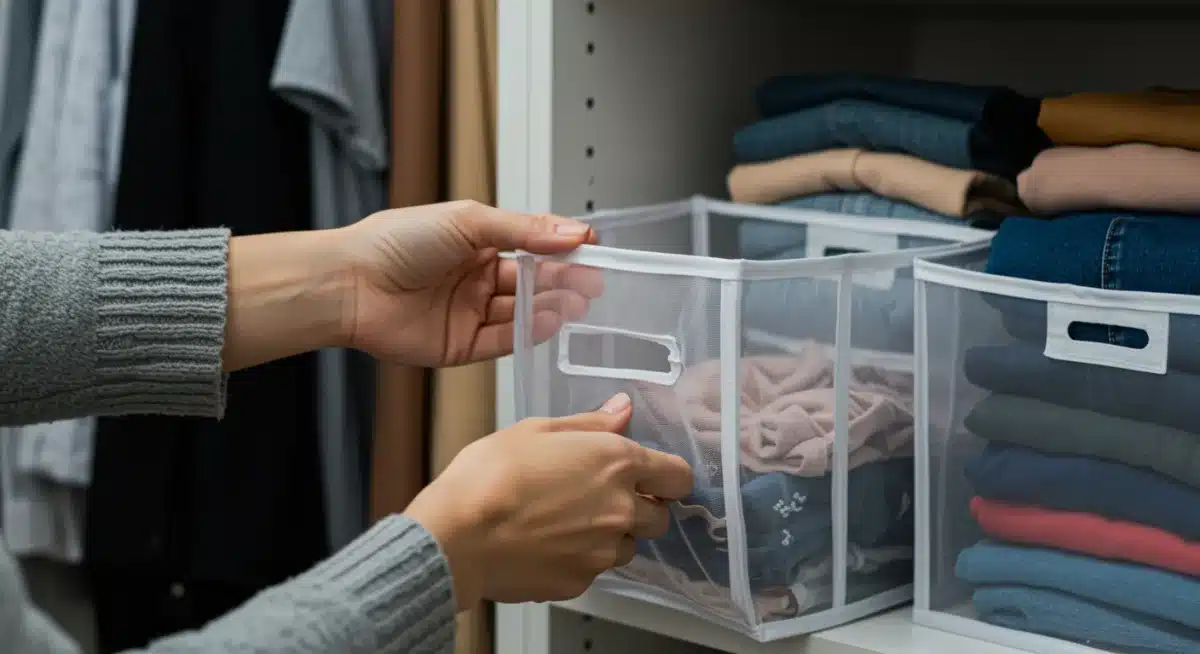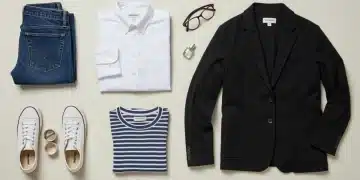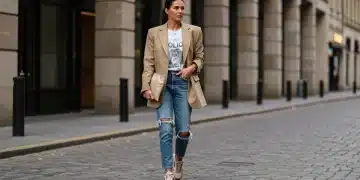Avoid These 3 Common Fashion Mistakes & Elevate Your Style

Advertisement
Many individuals unknowingly commit common fashion mistakes that hinder their personal style; understanding these pitfalls and implementing simple fixes can significantly enhance one’s overall appearance and confidence in daily dressing.
Ever wonder why some outfits just don’t feel right, even if the individual pieces are great? The truth is, many of us are making a few common fashion mistakes that can subtly undermine our entire look. But don’t worry, these aren’t insurmountable style challenges; they’re easily fixable habits that, once addressed, can transform your wardrobe and boost your confidence.
Understanding the Impact of Poor Fit
One of the most pervasive, yet often overlooked, fashion blunders is wearing clothes that simply don’t fit well. It’s a foundational element of good style, and yet, many people compromise on it for various reasons, from convenience to a misunderstanding of sizing. The impact of ill-fitting garments extends beyond mere aesthetics; it affects comfort, confidence, and how others perceive your attention to detail.
Advertisement
Clothes that are too tight can create unflattering bulges, restrict movement, and make you appear larger than you are. Conversely, garments that are too loose can swamp your frame, making you look shapeless and unkempt. The ideal fit skims your body without pulling or gaping, allowing for comfortable movement and highlighting your best features. This balance is crucial for projecting an image of polish and sophistication, regardless of the occasion or the price tag of your clothes.
The Problem with Generic Sizing
Retail sizing can be incredibly inconsistent, leading to confusion and frustration. A size ‘M’ in one brand might be entirely different from a size ‘M’ in another, making it difficult to find clothes that truly flatter your unique body shape. This discrepancy often leads people to settle for ‘good enough’ rather than ‘perfect fit.’
- Vanity Sizing: Many brands adjust their sizing to make customers feel better about buying a smaller size, further complicating the search for a true fit.
- Body Shape Variation: Standard sizes don’t account for the vast diversity in human body shapes, meaning a garment might fit well in one area but be too tight or loose in another.
- Material Properties: Different fabrics drape and stretch differently, influencing how a garment fits and feels on the body.
The Tailoring Solution
Investing in tailoring is not just for formal wear or expensive items; it’s a game-changer for almost any piece of clothing. A skilled tailor can transform an off-the-rack garment into a custom-fit piece, making a significant difference in your overall appearance without breaking the bank. Even minor adjustments, like hemming pants or taking in a waist, can elevate an outfit from mediocre to magnificent.
Advertisement
Consider tailoring as an extension of your personal style investment. It ensures that your clothes complement your body, rather than detracting from it. This simple step can make even the most basic pieces look luxurious and well-thought-out, proving that fit truly is king in the world of fashion. It’s about making your clothes work for you, not the other way around.
Mastering the art of proper fit is perhaps the most impactful step you can take to improve your style. It ensures comfort, enhances your silhouette, and communicates an intentional approach to your appearance. By prioritizing fit, you lay a strong foundation for a stylish and confident wardrobe that truly reflects you.
Ignoring Your Personal Color Palette
Another prevalent fashion mistake many people make is failing to understand and utilize their personal color palette. We often gravitate towards certain colors out of habit, trend, or simply because we like them. However, not all colors are created equal when it comes to complementing our natural skin tone, hair color, and eye color. Wearing colors that clash with your natural undertones can make you look washed out, tired, or even unhealthy, regardless of how well-designed the garment is.
Conversely, dressing in colors that harmonize with your natural palette can illuminate your face, make your skin glow, and enhance your features, creating a vibrant and cohesive look. This isn’t about restricting your choices but rather about making informed decisions that amplify your inherent beauty. It’s a subtle but powerful way to elevate your style and ensure you always look your best.
Identifying Your Undertones
The first step to discovering your personal color palette is understanding your skin’s undertones. While your skin tone might change with sun exposure, your undertone remains consistent. There are three main categories: cool, warm, and neutral.
- Cool Undertones: Look for blue or purple veins on your wrist. Silver jewelry tends to look better on you, and your skin might burn easily in the sun. Colors like true blues, emerald greens, deep purples, and cool grays often complement cool undertones.
- Warm Undertones: Your veins might appear greenish. Gold jewelry usually enhances your skin, and you tend to tan easily. Earthy tones such as olive green, mustard yellow, coral, and rich browns are often flattering.
- Neutral Undertones: You might have a mix of blue and green veins, and both silver and gold jewelry look good on you. You have more flexibility and can often wear a wider range of colors from both warm and cool palettes.
Building a Harmonious Wardrobe
Once you’ve identified your undertones, you can start building a wardrobe that truly makes you shine. This doesn’t mean discarding all your current clothes, but rather making conscious choices for future purchases. Think about how different colors interact with your complexion and how they make you feel.
Experiment with different shades within your palette. For example, if you have cool undertones, explore various blues from sky to navy. If you’re warm, try different reds from rust to terracotta. Incorporating these colors, especially near your face, can make a significant difference in your overall appearance and how radiant you look.

Understanding your personal color palette is a powerful tool for enhancing your style. It allows you to select clothing that not not only looks good on its own but also looks exceptional on you. By choosing colors that complement your natural features, you create a more polished, harmonious, and confident presentation, ensuring you always put your best foot forward.
Overlooking the Power of Accessories
The third common fashion mistake is underestimating or completely overlooking the transformative power of accessories. Many view accessories as mere afterthoughts, simple additions rather than integral components of an outfit. However, a well-chosen accessory can elevate a simple ensemble, express your personality, and tie an entire look together, taking it from ordinary to extraordinary.
Accessories, from jewelry and belts to scarves and handbags, offer an incredible opportunity to inject style, color, and texture into your wardrobe without needing to buy entirely new outfits. They are the finishing touches that communicate attention to detail and a keen understanding of personal style. Neglecting them is like serving a gourmet meal without seasoning; it might be good, but it lacks that essential spark.
Strategic Accessory Choices
Choosing the right accessories involves more than just picking something you like. It requires considering the occasion, the outfit’s overall aesthetic, and your personal style. The goal is to enhance, not overpower, your look.
- Jewelry: Can add sparkle, define a neckline, or draw attention to your hands. Consider the metal tones that complement your skin’s undertones.
- Belts: Can cinch the waist, create an hourglass silhouette, or add a pop of color or texture to an otherwise plain dress or tunic.
- Scarves: Offer incredible versatility, usable as neck adornments, headwraps, or even tied to a handbag for a chic touch. They’re perfect for adding color and pattern.
- Handbags: More than just a utility item, a handbag is a significant style statement. Choose bags that complement your outfit’s color scheme and the formality of the occasion.
The Art of Balance and Personal Expression
The key to successful accessorizing lies in balance and personal expression. Avoid over-accessorizing, which can make an outfit look cluttered. Instead, focus on a few key pieces that make a statement or subtly enhance your look. Think about the ‘less is more’ principle, but also don’t be afraid to experiment with bold pieces when the outfit calls for it.
Accessories are also a fantastic way to express your individuality and keep your wardrobe feeling fresh. They allow you to play with trends without committing to expensive, fleeting clothing items. A classic outfit can be completely transformed with a trendy pair of earrings or a contemporary belt, showing that you’re current without overhauling your entire closet.
By consciously incorporating accessories into your daily dressing, you unlock a powerful tool for personal expression and style elevation. They provide endless opportunities to refine your look, add character, and ensure that every outfit you wear feels complete and thoughtfully put together. Don’t underestimate their impact; they are the exclamation point to your fashion sentence.
Neglecting Wardrobe Maintenance and Organization
A less glamorous, but equally crucial, fashion mistake is the neglect of wardrobe maintenance and organization. It’s easy to get caught up in buying new clothes, but if your existing garments are uncared for, wrinkled, or lost in a chaotic closet, even the most stylish pieces will fail to make an impact. A well-maintained and organized wardrobe doesn’t just make it easier to get dressed; it preserves the quality of your clothes and ensures you always look polished.
Think about it: a beautiful silk blouse loses its appeal if it’s stained or creased. A sharp pair of trousers looks sloppy if they’re wrinkled from being crammed into a drawer. Prioritizing the care and arrangement of your clothing is fundamental to projecting a put-together image. This habit transforms your relationship with your clothes, turning dressing into an enjoyable and efficient process rather than a daily struggle.
The Downside of Disorganization
A disorganized closet can lead to several fashion pitfalls. When you can’t see what you own, you might forget about perfectly good items, leading to repetitive outfits or impulse purchases of things you already have. It also makes it harder to put together cohesive looks, resulting in rushed, mismatched choices.
- Lost Items: Garments often get lost in the back of the closet or under piles, making them inaccessible.
- Damage to Clothes: Cramming clothes can lead to wrinkles, stretching, or even damage to delicate fabrics.
- Time Waste: Searching for specific items or trying to find something that matches can consume valuable time, especially during busy mornings.
- Impulse Buying: Not knowing what you own can lead to buying duplicates or items you don’t truly need.
Strategies for a Well-Curated Closet
Creating an organized and well-maintained wardrobe is an ongoing process, but it’s incredibly rewarding. Start with a decluttering session, removing anything that doesn’t fit, is damaged beyond repair, or hasn’t been worn in a significant amount of time. Then, implement systems that work for you.
Invest in good quality hangers that support your clothes without distorting their shape. Organize by type, color, or season, whatever makes the most sense for your dressing habits. Ensure proper storage for delicate items, and make a habit of folding or hanging clothes immediately after wearing them (if they don’t need washing). Regular maintenance, like steaming or ironing, also plays a crucial role in keeping your clothes looking their best.

By dedicating time to wardrobe maintenance and organization, you ensure that every piece you own is ready to wear and looks its best. This attention to detail reflects positively on your overall presentation, making you appear more polished, intentional, and fashion-savvy. It’s an investment in your style that pays dividends every single day.
Underestimating the Power of Quality Basics
Another fashion mistake often made is the underestimation of quality basics. In the excitement of chasing trends or acquiring statement pieces, many overlook the foundational role that well-made, versatile basics play in a functional and stylish wardrobe. These aren’t just plain items; they are the workhorses that anchor countless outfits, providing a canvas upon which more expressive pieces can shine. Without a strong base of quality basics, even the most fashionable items can struggle to form cohesive and polished looks.
Investing in durable, well-fitting basic pieces like a classic white t-shirt, a perfectly cut pair of jeans, a versatile blazer, or a simple black dress can dramatically improve your daily dressing experience. These items stand the test of time, both in terms of durability and style, offering endless styling possibilities and ensuring you always have something reliable to wear, regardless of the occasion or trend cycle.
The Pitfalls of Cheap Fast Fashion Basics
While fast fashion offers tempting prices, opting for cheap, low-quality basics often proves to be a false economy. These items tend to lose their shape, fade, or show wear and tear quickly, requiring frequent replacement. This not only costs more in the long run but also contributes to textile waste and often involves unethical production practices.
- Poor Durability: Fabrics are often thin and prone to pilling, stretching, or tearing after a few washes.
- Inconsistent Fit: Cheap basics often lack the thoughtful tailoring and construction that ensure a flattering fit.
- Limited Versatility: Their short lifespan means they can’t serve as long-term foundational pieces for diverse outfits.
- Environmental Impact: The rapid consumption and disposal of low-quality garments contribute significantly to pollution and waste.
Building a Foundation of Quality
Building a wardrobe with quality basics means prioritizing longevity, versatility, and comfort. It’s about making thoughtful purchases that will serve you well for years, not just a season. Look for natural fibers like cotton, wool, linen, and silk, which tend to be more durable and comfortable. Pay attention to stitching, seams, and overall construction, as these are indicators of quality.
Consider the cost-per-wear principle: a more expensive, high-quality basic that you wear hundreds of times is ultimately a better investment than a cheap item worn only a few times. These foundational pieces will form the backbone of your wardrobe, allowing you to easily mix and match, create new combinations, and adapt to various styles and occasions with ease and confidence.
Recognizing the value of quality basics is a cornerstone of smart fashion. By investing in well-made, versatile pieces, you create a resilient and adaptable wardrobe that makes dressing effortless and enjoyable. This strategic approach ensures your style is grounded, enduring, and always ready to impress, regardless of the fleeting trends.
Sticking to a Style Rut and Avoiding Experimentation
One of the most insidious fashion mistakes is falling into a style rut and resisting any form of experimentation. It’s comfortable to stick with what you know works, but this comfort can quickly turn into boredom and a missed opportunity for personal growth and expression. Fashion is meant to be fun, a way to explore different facets of your personality and adapt to the evolving world around you. When you cease to experiment, your style can become stagnant, making you feel less confident and less engaged with your wardrobe.
Breaking out of a style rut doesn’t require a complete overhaul or a dramatic transformation. It can be as simple as trying a new color, a different silhouette, or combining existing pieces in novel ways. The goal is to reignite your creativity and discover new dimensions of your personal style, ensuring your fashion choices remain exciting, relevant, and truly reflective of who you are today.
Signs You’re in a Style Rut
Recognizing that you’re in a style rut is the first step towards breaking free. There are several common indicators that your wardrobe might be feeling a bit too predictable or uninspired:
- Repetitive Outfits: You find yourself wearing the same few combinations over and over, even when you have other clothes.
- Lack of Excitement: Getting dressed feels like a chore, and you rarely feel truly excited about what you’re wearing.
- Ignoring New Trends: You dismiss new trends outright without considering how they might be adapted to your personal style.
- Fear of the Unknown: You avoid trying on new styles or colors in stores, sticking only to what you’ve always bought.
Gentle Steps Towards Experimentation
Experimenting with fashion doesn’t have to be intimidating. Start small and gradually push your boundaries. The aim is to find what feels good and authentic to you, not to mimic someone else’s style or force yourself into something uncomfortable.
Try incorporating one new trend piece into your existing wardrobe, like a different style of shoe or a uniquely textured top. Mix patterns or textures you wouldn’t normally put together. Visit different stores or browse online boutiques you haven’t explored before. Even simply trying on clothes you wouldn’t usually consider can open your eyes to new possibilities and help you rediscover the joy of personal expression through fashion. Remember, style is a journey, not a destination, and continuous exploration keeps it vibrant.
Embracing experimentation is vital for a dynamic and evolving personal style. By daring to step outside your comfort zone, even in small ways, you unlock new avenues for self-expression, keep your wardrobe fresh, and maintain a joyful connection with your clothing choices. Don’t let habit stifle your style; let curiosity lead the way to new and exciting fashion discoveries.
Forgetting the Importance of Comfort and Confidence
The final significant fashion mistake, and perhaps the most crucial, is forgetting the paramount importance of comfort and confidence in your clothing choices. Fashion is often perceived as something external, a facade to impress others, but its true power lies in how it makes you feel internally. If your clothes are uncomfortable, restrictive, or make you feel self-conscious, no matter how stylish they appear, they fail in their most fundamental purpose. True style emanates from within, projected outwards when you feel at ease and assured in what you’re wearing.
Prioritizing comfort doesn’t mean sacrificing style; it means making conscious choices about fabrics, cuts, and overall wearability. When you are comfortable, you move more freely, your posture improves, and your overall demeanor becomes more relaxed and approachable. This natural ease translates directly into confidence, making you appear more put-together, charismatic, and genuinely stylish than any trend or expensive label ever could.
The Discomfort-Confidence Connection
There’s a direct correlation between how comfortable you are in your clothes and how confident you feel. If you’re constantly tugging at a too-tight waistband, adjusting a slipping strap, or feeling restricted by a stiff fabric, your focus shifts from engaging with the world to managing your discomfort. This distraction can subtly chip away at your confidence, making you less present and less able to project your true self.
- Physical Restriction: Clothing that restricts movement can make you feel trapped and physically uncomfortable.
- Itchiness/Irritation: Certain fabrics or tags can cause constant irritation, leading to fidgeting and distraction.
- Self-Consciousness: Ill-fitting or overly revealing clothing can make you feel exposed or worried about how you look, instead of focusing on your day.
- Lack of Authenticity: Wearing clothes that don’t align with your personal comfort level or lifestyle can feel like wearing a costume.
Dressing for Your Best Self
Dressing for comfort and confidence means choosing clothes that not only look good but also feel good on your body. It involves understanding your personal preferences for fabrics, silhouettes, and levels of formality. This doesn’t mean resorting to sweatpants every day, but rather finding stylish alternatives that offer ease of wear and allow you to move through your day unencumbered.
Focus on breathable fabrics, well-constructed garments, and pieces that flatter your body shape without being overly tight or loose. When you try on an item, pay attention to how it feels. Can you sit, stand, and move comfortably? Does it make you feel empowered and ready to tackle your day? If the answer is yes, you’re on the right track. Remember, the best outfits are those that allow your personality to shine through, unhindered by discomfort or self-doubt.
Ultimately, the most significant fashion statement you can make is one of comfort and confidence. By prioritizing how your clothes make you feel, you unlock a powerful synergy between your inner self and outer presentation. This approach ensures that your style is not just visually appealing but also a true reflection of your well-being, allowing you to move through life with grace, ease, and undeniable self-assurance.
| Fashion Mistake | How to Fix It |
|---|---|
| Poor Fit | Invest in tailoring for garments to ensure they perfectly skim your body, enhancing silhouette and comfort. |
| Ignoring Color Palette | Identify your skin’s undertones (cool, warm, neutral) and choose colors that illuminate your face and complement your natural features. |
| Overlooking Accessories | Use well-chosen accessories like jewelry, belts, or scarves to elevate outfits, add personality, and tie looks together. |
| Neglecting Wardrobe Care | Maintain an organized closet and properly care for garments to ensure they always look polished and ready to wear. |
Frequently Asked Questions About Fashion Mistakes
Clothes should skim your body without pulling, gapping, or restricting movement. Pay attention to seams, which should lie flat, and observe if fabric bunches uncomfortably. If you can’t move freely or if the garment feels too tight or too loose in any area, it likely needs tailoring or a different size.
Skin undertones are the subtle colors beneath your skin’s surface, typically cool (blue/pink), warm (yellow/peach), or neutral. They matter because wearing colors that harmonize with your undertones can make your skin look more vibrant and healthy, while clashing colors can make you appear washed out.
Accessories can add personality, texture, and color to a basic outfit, elevating it from simple to stylish. A statement necklace can define a neckline, a belt can cinch a waist, and a colorful scarf can add a pop of visual interest, making the entire look more polished and unique.
Generally, fewer quality clothes are better. Quality items tend to last longer, fit better, and provide more versatility for mixing and matching. While the initial investment might be higher, they often prove more cost-effective in the long run and contribute to a more sustainable and cohesive wardrobe.
Start by experimenting with small changes, like trying a new color, a different silhouette, or combining existing pieces in novel ways. Seek inspiration from fashion blogs or magazines, and don’t be afraid to try on items you wouldn’t normally consider. The goal is to reignite your creativity and discover new personal style dimensions.
Embracing a More Intentional and Confident Style
Addressing these common fashion mistakes is not about adhering to rigid rules, but rather about cultivating a more intentional and mindful approach to your wardrobe. By prioritizing proper fit, understanding your personal color palette, leveraging the power of accessories, maintaining your wardrobe, avoiding style ruts, and always valuing comfort and confidence, you unlock a powerful pathway to a truly authentic and elevated personal style. These adjustments are not just about looking better; they’re about feeling better, more self-assured, and more capable of expressing who you are through your clothing choices. Embrace these insights, and watch as your fashion journey transforms from a series of accidental outfits into a confident and joyful expression of yourself.





